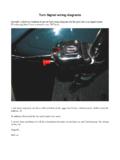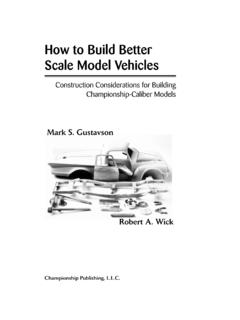Transcription of http://www.ocmodelt.com/Ttips/Tech%20Service/coilbooster/CoilswithoutMagneto.pdf
1 Running Model T Ford Coils without the Magneto. Here, I present an adaptor to provide 9V DC for coil operation with no modifications required. This unit provides 9V to the coils in a Model T Ford with a standard 6V electrical system. Background to the Model T ignition system. The Ford ignition system comprises four separate ignition coils, each with its own vibrator contacts. These are connected directly to each of the four spark plugs. As to which spark plug is firing at any given time, that is determined by switching the low voltage supply to each coil in turn.
2 This is done by a device called a "commutator" or "timer". It's mounted at the end of the camshaft and is essentially a four way switch. Similar to a distributor, but low voltage. The supply for the ignition coils comes from either a magneto or a battery. Much has been written on the subject in various Model T literature and on the Model T Forum. Suffice to say, the magneto provides about 6 to 30V AC, the voltage and frequency dependent on engine speed. Because of how the coils operate, and the waveform produced by the magneto, the ignition timing operates differently when operating on the magneto than when on battery.
3 The Ford coils also can operate on a battery. This is the 6 volt accumulator in the 1919-1927 cars. Prior to this, the battery was optional and could consist of a number of different types, a dry cell "Hot Shot", a collection of dry cells making a 6 or 9V battery, or a 6 or 12V storage battery - this being more likely if the car had been updated to include electric lighting. On the subject of dry cells, these are still available today, although they are no longer known by this type number. The best source is radio control model suppliers where they are sold as glow plug starter batteries. They are the real deal, carbon zinc cell just with a more modern label.
4 There are also reproductions that take ordinary size D cells inside a replica casing. The battery option was provided in the 1909 -1919 cars simply because unless the magneto is perfect the car is much easier to start on battery. The continuous spark helps, apart from the battery voltage being higher than what comes from the magneto when turning the engine by hand. Prior to the Model T, cars like the Model N which used the four coil and commutator system ran on battery only, although an accessory dynamo was available from 3rd party manufacturers such as KW. However, the problem was dry cells can't be recharged and no means was provided to charge storage batteries in these cars.
5 So, it was a pain having to replace dry cells all the time or take the storage battery to a garage to be recharged. Needless to say, some drivers were stranded with flat batteries. One of the improvements that the Model T was to include was not to have to rely on a battery at all. This is where the flywheel magneto comes into the picture. 16 magnets mounted around the flywheel induced current to flow in adjacent coils mounted on the back of the engine block. Magneto problems. Unfortunately, the idealistic design has a number of disadvantages. Over time the magnets weaken, the vibration and hot temperatures assisting with their deterioration.
6 So, although initially not approved of by Ford, methods were developed to recharge the magnets in the car. The distance between the magnets and field coils is critical. Too close and they hit each other at 2000rpm resulting in broken magnets and damaged field coils. Too far apart, as happens when the 3rd crankshaft bearing wears, and the voltage decreases making for weaker ignition. Sometimes the magnets are cracked and eventually fly apart. Then there's the field coils themselves. These are prone to short circuits. All that hot oil is hard on the insulation. Sometimes it flakes off and metallic particles become embedded between turns of the copper coils, reducing output in varying degrees.
7 In some cases, the coils detach from the bobbin plate and once they come into contact with the magnets, there's several metres of copper ribbon wrapped around the flywheel and transmission. The worst aspect of all this is that the engine has to be removed to service most faults with the magneto. In my opinion, it is one aspect of the Model T design that could have been improved. The external dynamo of the Model N would seem a better idea. My own car. The magneto in my own car was partially operative when I got it, but output was too low to run at idle. I had noticed damage to one of the field coils where attempts had been made to remove the starter motor without removing the bendix first.
8 Apart from this, attempts to remagnetise the magnets in the car did not work. This was right at the start of my Model T learning curve back in 2002. I had seen messages in the Model T Forum that the coils wouldn't operate properly on 6V at driving speed and that a 12V supply would have to be used or a distributor ignition system used. Neither were acceptable for my car. But, as it turned out, my car seemed to operate perfectly well with 6V powering the coils, and other club members who drove it said that it "drives just like a typical T". And so, I stopped worrying about the inoperative magneto. When I rebuilt the engine in January 2010, I removed the magneto and replaced the magnets with commercially made paddles to keep the oil circulating.
9 As it was, the coil insulation had deteriorated on a number of coils and there was miscellaneous damage from various objects that had fallen into the transmission. I thought long and hard about restoring the magneto, but ultimately, the magnets would still weaken over time, they could still break off at 2000rpm, and the coils could still detach themselves making a mess. Plus I'd driven the car for over seven years without it and wouldn't miss it. Not only is the flywheel so much easier to work on, but service access in the transmission is so much better. The lighter flywheel should also prolong the life of the 3rd bearing.
10 Regarding the paddles, I used the ones from Texas T Parts as they were braced against bending. However, the supplied ring gear bolts cannot be used as they will only jam up and break. Someone has stuffed up somewhere and there's now three sizes of repro ring gear bolts doing the rounds. No magnets to break off, no field coils to come apart, and heaps better service access! The original bolts are #14-24, but one of the repro parts manufacturers interpreted this as 1/4" -24. Hence we have two kinds of repro ring gear screw in circulation. Some repro ring gears are tapped for the 1/4" thread. Some of the oil paddle kits come with 6mm screws, and this is what I've used.




